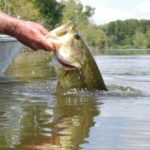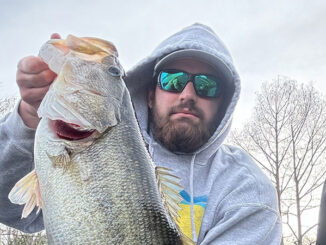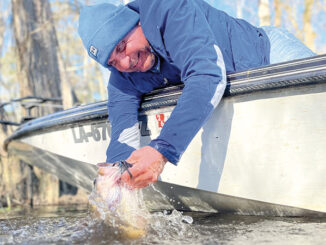
Study shows hypoxia doesn’t move fish
Largemouth bass can be finicky, temperamental creatures under the best of circumstances. When the effects of environmental stressors are added, catching them can seem nearly impossible.
The single most-important environmental factor that stresses bass is dissolved oxygen in the water, or rather the lack of dissolved oxygen.
This is especially true in South Louisiana’s marshes and swamps.
Both habitats are overrun with aquatic plant growth. Every plant that grows will eventually die. And dead, rotting plant matter consumes enormous amounts of dissolved oxygen.
Decay and its oxygen use are most aggressive in summer months, the very same period that dissolved oxygen levels are at their lowest. For reasons of chemistry, hot water holds much less oxygen than does cold water.
Most bass fishermen can recognize hypoxic (low-oxygen) waters, whether by color, clarity or even odor. They also quickly recognize they don’t catch bass in hypoxic water.
What they don’t know is where the bass go or what they do. Do they leave the area, as many people believe, or do they just tough it out?
It was to answer these questions that Paige O’Malley, a Nicholls State University Department of Biological Sciences graduate student doing research for her master’s thesis, put a project together in the marshes and swamps surrounding Lac Des Allemands.
Lac Des Allemands’ wetlands receive no water from the Mississippi River or any other outside source, instead depending solely on rainfall as a source of fresh water.
However, the area is well known for fish kills when large amounts of rain fall in a short period of time, flushing hypoxic from under floating vegetation into bayous and the lake itself.
This is particularly true after huge rain events associated with hurricanes.
O’Malley’s plan was to shock largemouth bass and mount radio tags that fit like small saddles on the backs of the fish before releasing them. She would then return to the area every other week, measure water quality for oxygen and relocate the fish by tuning into the signals transmitted from the tags.
O’Malley recognized that even during hypoxic events, some areas in and around Lac Des Allemands can have high oxygen levels.
In response, she spread her research into four different areas: Bay Chevreuil (five tagged bass), Bayou Des Allemands (14 tagged bass), North End (10 tagged bass) and Pleasure Bend (11 tagged bass).
Of the 40 bass tagged and released during the course of the study, two tags malfunctioned and eight tagged fish disappeared, leaving 30 fish to be followed.
As expected, some waters in the study area became hypoxic during the warmer months between June and October.
But the reactions of the tagged fish to hypoxia surprised O’Malley.
She went into the project assuming largemouth bass populations maintained themselves in the areas by fish moving away from areas of low oxygen to areas of higher dissolved oxygen.
But there was no movement from one area to another over the course of the study.
Additionally, the fish in each area did not show significantly more overall movement during hypoxia than during normal oxygen conditions.
Some individual fish did show more movement than others, though.
On the high end, one North End fish moved an average of 66 yards per day. Another Pleasure Bend fish moved only a matter of a few feet, in spite of having been relocated 10 times during the study period.
Movement seemed to have more to do with an individual fish’s behavior than with the effects of hypoxic conditions.
In general, largemouth bass in the North End showed eight times as much average movement than did those in Pleasure Bend. Bayou Des Allemands and Bay Chevreuil bass showed movement that was fell somewhere between the other two areas.
The bass in the study did not move in response to low-oxygen conditions. They didn’t die, either: O’Malley was able to locate them again and again.
So how did they survive?
The answers were beyond what O’Malley’s study was designed for, but she made some speculations that fell into two classes: behavioral changes and physiological changes.
Behavioral changes include finding a refuge, increasing operculum (gill cover) movement and energy conservation.
Fish are very sensitive to their environment, and finding a tiny microhabitat with a tiny bit more oxygen could be the difference between survival and death.
Increased movement of the gill covers of a fish would push more water over the gills. If the water holds any oxygen at all, the fish might be able to glean what it needs from the increased amount of water pumped over the gills.
Energy conservation is a natural response of a fish to low oxygen supplies. The more active a fish (or any other animal) is, the higher would be its need for oxygen to supply moving muscles. Fishermen often note that fish don’t feed or strike lures in low-oxygen conditions.
Physiological changes include altered blood chemistry, gill remodeling and metabolic suppression.
Oxygen is carried in the blood of fish, as in any other animal. As the composition of blood is not fixed, many factors can change its chemistry.
O’Malley considered a possible increase in hemoglobin concentration in the blood and/or an increase in the oxygen affinity of the hemoglobin. This would allow for an increase of oxygen picked up in the blood.
Gill remodeling is an interesting aspect that has been shown to happen in other fish species. If the surface area of a gill is somehow made larger, more of the gill will be exposed to the water and more of what little oxygen is in the water can be taken up by the gill.
Remodeling to increase the gills’ surface area in those species where it has been seen takes place fairly quickly and is not a permanent change, seeming to occur when needed by the fish. Contrary to anything that makes common sense, gill remodeling occurs through the death of tissue around gill folds because of hypoxia.
Metabolic suppression is simply a way of slowing body processes that burn oxygen. The less active a body is the less oxygen is needed. Hibernation in mammals is an extreme form of metabolic suppression.





